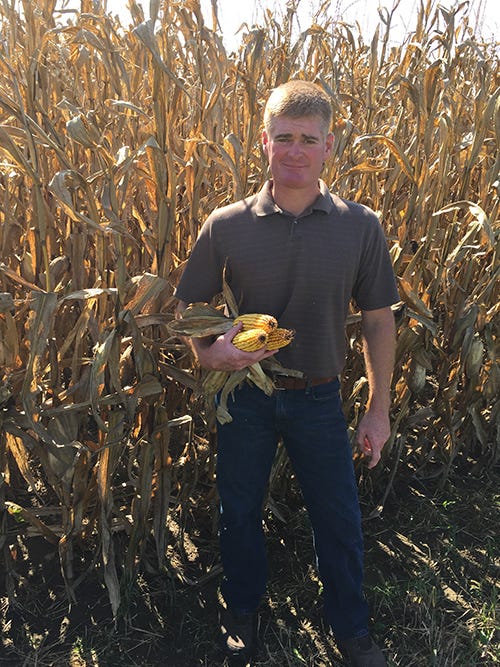January 18, 2017

Think Different
Adam Graham follows specific guidelines when evaluating biologicals on his fields. He suggests:
1. Select a field with minimal variability in soil type, drainage or other factors.
2. Get soil pH and fertility to hit recommended levels
3. Compare products in replicated trials, with controls when possible.
-----
Biopesticides used in combination with conventional fungicides have proven themselves in recent years. Now, biostimulants and biofertilizers are moving into the accepted category as companies big and small introduce products that deliver grower beneifts.
It is a trend that is building quickly, according to Dave Lanciault, president and CEO, Agricen Sciences.
"The irony is that people were trained to think of a biological system – plants growing in the soil – in chemical terms, with all the new products to improve productivity coming from chemical sources," says Lanciault. "Now, there is growing acceptance that we need to optimize the biological system, the plant and the microbial ecology that surrounds it. Logic suggests we need to tap into biological sources to do it."
Equally important is that neither industry nor growers see "silver bullets" that solve big problems by themselves, suggests Lanciault, arguing instead for a systems approach to manage a biological system.
One reason that is so necessary is the multi-functionality of many biologicals. The recent introduction of Titan XC, a fertilizer biocatalyst by Agricen, is a good example. It promises to increase nutrient availability and enhance root growth and function, formulated for use with dry fertilizer blends.
Defining benefits a challenge
Multiple functionality of biologicals is both the blessing and the curse. Defining what a product does can be a real challenge.
Justin Clark, technical marketing manager, BASF, says the company is introducing five new biological seed treatments within the next five years, 20 new biologicals all together.
"The seed treatments function in all three categories -- biostimulant, biopesticide and biofertilizer," says Clark. "However, we are taking a really broad approach as to where they fit best, whether as a biofungicide or as a biostimulant."
Bioag, the alliance of Novozymes Biologicals and Monsanto, is taking a different approach. They are using big data to evaluate thousands of organisms in half a million field plots this year and next, searching for a yield benefit. Application sites are also being mined for data on biotic and abiotic aspects of the soils, pest and pathogen pressure, not to mention sequencing whole genome of the organisms being introduced to the field.
"Once we have the yield determined, the other data will allow us to figure out the how and the why," says Shawn Semones, director, BioAG R&D. "With genome sequencing, precision analytics, imaging and massive data sets, we can now unravel some of the questions that have challenged biologicals."
Yield inconsistency
One of those questions might examine why biologicals have had a reputation for inconsistent yields within the same field or from year to year. Corn and soybean grower Adam Graham is a confirmed user of biologicals on the 2,000 acres he farms with his father and brother in Northcentral Ohio. However, unanswered questions remain, even with products that have proven themselves. 
"I've tried lots of different biologicals, mostly as partners with conventional products," he says. "The ones I've stayed with have always paid for themselves, if not their handling. I'm always looking for products that can enhance soil health and make crops use nutrients more efficiently, especially if that means reducing nutrient load."
One of these is Triton, a biological based starter fertilizer alternative laid down with his corn. It includes six different components developed by LidoChem, Inc. and formulated by Novus Ag, his local retailer. While it includes some macro and micronutrients, it is the biologicals that carry the load. Product claims include fixing nitrogen, metabolizing and mobilizing nutrients in the soil, cycling nutrients, enhancing organic matter decomposition and enhancing water and nutrient uptake.
Graham switched to Triton from a previous biological starter alternative that delivered a five-bushel per acre yield bump over no starter. Triton gave him an additional 8 bushels/acre on a 100-acre field split between the two. While it was enough for him to switch all his corn acres, his analysis also raised questions thanks to his intensive, half-acre grid soil sampling.
"Triton seems to perform best in areas with low organic matter and low CEC (Cation Exchange Capacity)," says Graham.
Getting answers to questions like Graham's is exciting to Semones. "Consistency has been a challenge, but now we are better able to find microbes and understand how they behave when applied," he says.
Lanciault identifies nutrient utilization and and abiotic stress tolerance as the two major trends in industry research, noting that Agricen has introduced four new products in these areas in the past year. However, big data analysis such as Semones describes may uncover new biological solutions to further spur productivity.
"Traditionally, if we wanted a fungicide, we would screen for it in the lab and then the greenhouse and eventually the field," he says. "We now have the data in our plots to determine whether the yield enhancing organism is fixing nitrogen, liberating phosphorus, suppressing nematodes, controlling insect damage or something else."
About the Author(s)
You May Also Like




